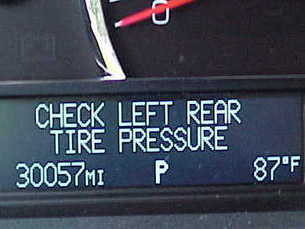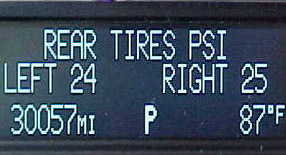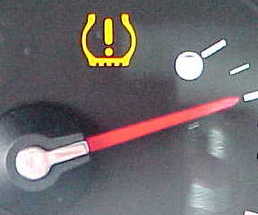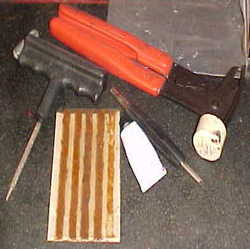Cadillac Tire Pressure Warning Light

This morning I was greeted by the tire pressure warning light on my 2009 Cadillac SRX. Although I am no stranger to the warning light and the monitoring system that turns it on this was the first time I’ve seen it on my own personal vehicle.
The Cadillac is equipped with a driver information center referred to in the owner’s manual has DIC. So I scrolled through the information that was available on the Dic to confirm the original message of check left rear tire. Lo and behold the left rear tire was the lowest one on the vehicle coming in at 24 psi
The first thing that crossed my mind was that yesterday there was no warning lights and everything was just fine, the tires where reading 25 psi across the board. But overnight we had low humidity and clear skies that allowed the temperature to drop into the upper 60s. This reduced the pressure just enough to trigger the dash warning light. What a difference a single psi of air can make.

I had the rear tires replaced about a year ago and they were filled to the recommended 30 psi at the time of installation. Even the best tires mounted on the best rims can lose very small amounts of air pressure with no problems stemming from external damage such as nails, tacks and spikes puncturing the tread area. Four or five psi of lost air a year is considered by many to be a normal condition.
When I went to fill the tires I employed a little trick that I and my sister had figured out on her 2009 Nissan Ultima. I put together a quick video on YouTube that I’ll make available at the very bottom but what it boils down to is, the tire pressure monitoring system will recognize adjustments in pressure quicker when you add air with the ignition key on.
Even though I did fill the tires with the key on the tire pressure warning light remained on until I got the vehicle out on the road and rolled over 55 mph. Also note that when you do fill the tires, they should be as cold as possible! Never fill a tire after driving for long periods of time because the heat will boost the pressure just as the cold will reduce it.
Common Problems that Turn on the Tire Pressure Warning Light

As I stated earlier I am no stranger to the tire pressure warning light and problems with tires overall. No matter how expensive the tire is or even how well it’s made it is still susceptible to external damage from junk lying in the road. Most often when someone comes in with the warning light on I’ll find a nail or something.
The question is what to do after you find a nail. The answer to this question really depends on the current condition of the tires. If the tire is more than 75% worn your best bet would be to replace the tire. In Fact I would recommend that you replace them in pairs whether it is 2 rear tires or two front tires. Most mechanics recommend rotating the new ones to the back.
If the tires still have a lot of life left in them, I would strongly recommend an inside patch be installed at a tire repair center. I recommend someone who specializes because often they will not only have the most experience but they will also have the freshest most modern supplies to carry out the repairs.

The way that the inside patch is installed is important. An area is scuffed around the whole and then a specialized rubber patch is glued into place with specialized Epoxy. This only holds the patch in place when you refill the tire it’s the actual inside air pressure that pushes the patch outward to seal the hole. If done properly this repair can truly make the tire as good as new. On the other hand what I would avoid is using a tire plug that is installed from the outside and put into the whole. Although a tire plug can hold and it certainly is a lot cheaper to use one as opposed to the patch method I would consider this more of a temporary repair. Most tire plugs are what they call self vulcanizing. After they are installed they continue to harden. Eventually the plug gets so hard that air starts to leak around it.
So you might as well fix it right the first time or you could wind up with a pressure warning light that comes on every month, or surprised by a flat tire one morning if the plug comes out. For more of the latest articles to the auto repair information blog this next link will take you back to the homepage.

